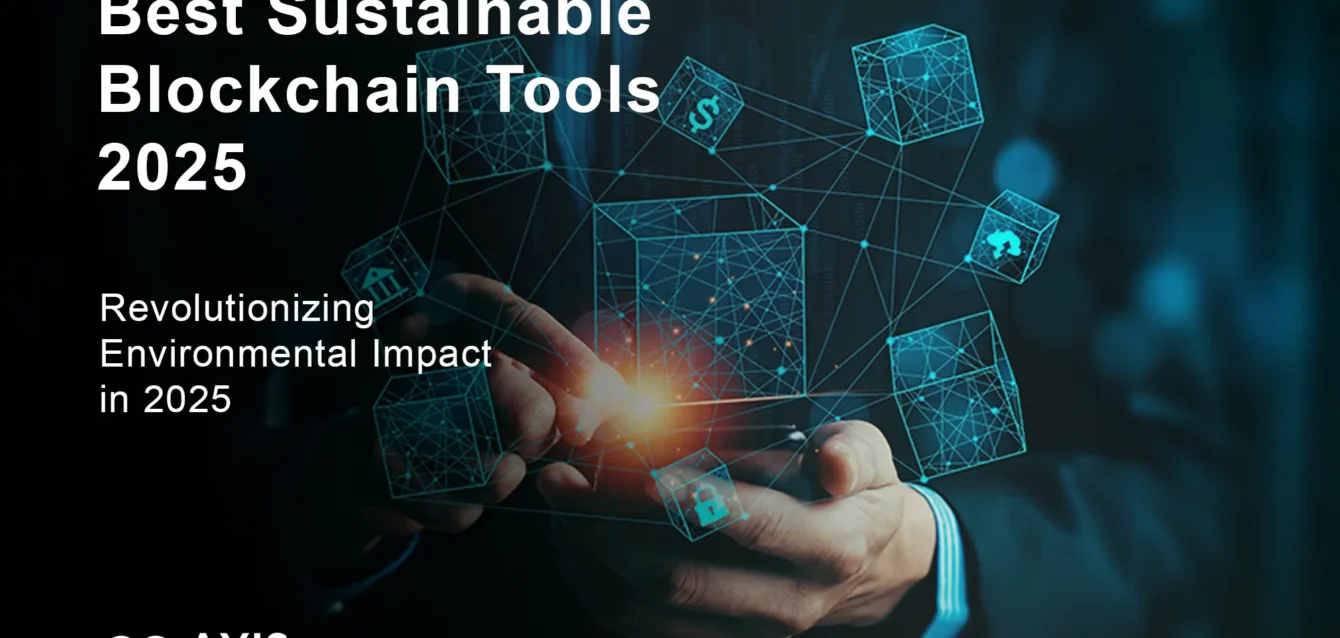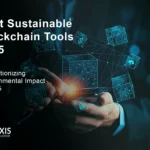Best Sustainable Blockchain Tools 2025
The blockchain industry consumed over 140 terawatt hours of electricity in 2024 alone—more than entire countries like Argentina. Yet buried within this staggering statistic lies a remarkable transformation happening right now: sustainable blockchain tools are rewriting the rules of how distributed technologies can operate without devastating our planet.
What started as an environmental crisis has sparked the most significant innovation wave in blockchain’s short history. From carbon-negative Kryptowährungen to supply chain transparency tools that prevent greenwashing, sustainable blockchain technologies aren’t just reducing energy consumption—they’re actively helping solve climate change.
This comprehensive analysis reveals the sustainable blockchain tools that are actually delivering measurable environmental benefits, how they work, and why major corporations are abandoning traditional Blockchain infrastructure for these green alternatives.
Inhaltsübersicht
- Understanding Sustainable Blockchain Technology
- Energy-Efficient Consensus Mechanisms
- Top Sustainable Blockchain Platforms
- Green DeFi and Financial Tools
- Supply Chain Sustainability Solutions
- Carbon Trading and Offset Platforms
- Renewable Energy Blockchain Applications
- Environmental Monitoring and Reporting Tools
- Enterprise Adoption of Green Blockchain
- Implementation Strategies for Organizations
- Future Trends and Innovations
- Measuring Environmental Impact
Understanding Sustainable Blockchain Technology
Sustainable blockchain tools represent a fundamental shift from the energy-intensive proof-of-work systems that dominated the early Krypto era. These technologies prioritize environmental responsibility while maintaining the core benefits of decentralization, transparency, and security.
What Makes Blockchain Tools Sustainable?
The sustainability of blockchain tools depends on three critical factors:
Energy Efficiency: Modern sustainable platforms consume 99.9% less energy than Bitcoin. Ethereum’s transition to Proof-of-Stake reduced its energy consumption from 78 TWh annually to just 0.01 TWh—equivalent to a small city rather than an entire country.
Carbon Footprint Reduction: Leading green blockchain platforms like Algorand have achieved carbon-negative status, meaning they actually remove more CO2 from the atmosphere than they produce through their operations.
Renewable Energy Integration: Platforms like Energy Web Chain specifically facilitate renewable energy trading and grid management, creating positive environmental impact beyond just reducing their own consumption.

The Economics of Green Blockchain
The financial incentives for sustainable blockchain adoption are compelling. Organizations implementing green blockchain solutions report average cost savings of 40-60% on energy expenses compared to traditional infrastructure. More importantly, these tools unlock access to the $30 trillion ESG investment market, where sustainability credentials directly impact funding availability.
The regulatory landscape is also driving adoption. The European Union’s upcoming sustainability reporting requirements will mandate blockchain-based environmental tracking for companies with revenues over €40 million, creating massive demand for these tools.
Energy-Efficient Consensus Mechanisms
The backbone of sustainable blockchain tools lies in their consensus mechanisms—the protocols that validate transactions and maintain network security without requiring massive computational power.
Proof-of-Stake (PoS) Systems
Proof-of-Stake represents the most mature alternative to energy-intensive mining. Instead of competing to solve complex mathematical puzzles, validators are chosen based on their stake in the network.
Ethereum 2.0: The world’s second-largest blockchain completed its transition to PoS in September 2022, reducing energy consumption by 99.95%. This transition eliminated approximately 11 million tons of CO2 emissions annually—equivalent to removing 2.4 million cars from the road.
Cardano: Built from the ground up with PoS, Cardano consumes roughly 0.5479 kWh per transaction compared to Bitcoin’s 700 kWh. The platform’s Ouroboros protocol is the first PoS system to be mathematically proven secure.
Polkadot: Uses Nominated Proof-of-Stake (NPoS), which adds democratic elements to validator selection while maintaining energy efficiency. The platform’s parallel processing capabilities handle thousands of transactions with minimal energy overhead.
Innovative Consensus Models
Proof-of-Space-and-Time (PoST): Chia Network pioneered this approach, using unused hard drive space instead of computational power. The network consumes approximately 500 times less energy than Bitcoin while maintaining comparable security.
Proof-of-Authority (PoA): Used in private and consortium blockchains, PoA relies on pre-approved validators, drastically reducing energy consumption. This model is particularly effective for enterprise sustainability tracking applications.
Delegated Proof-of-Stake (DPoS): Platforms like EOS and TRON use DPoS to achieve high transaction throughput with minimal energy consumption. The democratic delegation system ensures decentralization while maintaining efficiency.
Top Sustainable Blockchain Platforms
Algorand: The Carbon-Negative Pioneer
Algorand stands as the first major Blockchain to achieve carbon-negative status. The platform’s Pure Proof-of-Stake consensus mechanism enables 1,000 transactions per second while consuming only 0.0000008 kWh per transaction.
Wesentliche Merkmale:
- Carbon-negative operations since 2021
- 4.5-second transaction finality
- Smart contract capabilities with minimal environmental impact
- Partnership with ClimateTrade for continuous carbon offset purchasing
Real-World Applications:
- Marshall Islands’ digital currency (SOV)
- FIFA’s NFT marketplace
- Sustainable supply chain tracking for major retailers
Environmental Impact: Algorand removes approximately 17,000 tons of CO2 annually through its carbon offset program, making every transaction contribute to environmental restoration.
Hedera Hashgraph: Enterprise-Grade Efficiency
Hedera utilizes a unique hashgraph consensus mechanism that’s inherently more efficient than traditional blockchain structures. The platform achieves 10,000 transactions per second while maintaining enterprise-level security.
Sustainability Metrics:
- Uses 0.00017 kWh per transaction
- Governed by a council including Google, IBM, and Boeing
- Carbon-neutral operations with ongoing offset programs
- LEED-certified data centers powered by renewable energy
Enterprise Adoption: Over 40% of Fortune 500 companies have pilot programs using Hedera for supply chain transparency and sustainability reporting.
Tezos: Self-Amending Green Blockchain
Tezos combines energy efficiency with on-chain governance, allowing the platform to upgrade without hard forks. This self-amending capability ensures long-term sustainability without network disruptions.
Environmental Advantages:
- PoS consensus with minimal energy requirements
- Self-upgrading protocol reduces technical debt
- Focus on digital art and NFTs with lower environmental impact
- Partnership with Quantified Ventures for impact measurement
Innovation Focus: Tezos has become the preferred platform for environmentally conscious NFT projects, hosting over 60% of climate-focused digital art initiatives.
Flow: Developer-Friendly Sustainability
Created by the team behind CryptoKitties, Flow was designed from inception to be both developer-friendly and environmentally responsible.
Technical Innovation:
- Multi-role architecture that separates consensus and computation
- No mining or complex cryptographic puzzles
- Native support for consumer applications
- Integration with renewable energy certificate tracking
Auswirkungen auf die reale Welt: Flow powers NBA Top Shot and other major consumer applications, proving that sustainable blockchain tools can handle mainstream adoption without compromising user experience.
Green DeFi and Financial Tools
The decentralized finance (DeFi) sector has embraced sustainability as both an ethical imperative and a competitive advantage. Green DeFi platforms are attracting increasing investment as traditional finance seeks environmentally responsible alternatives.
Sustainable DeFi Protocols
Polygon: This Ethereum layer-2 solution has committed to being carbon-negative by 2022. The platform reduces transaction costs by 99% while maintaining Ethereum compatibility.
- Green Pledge: $20 million committed to carbon offset and sustainability initiatives
- Effizienzgewinne: 10,000x more energy-efficient than Ethereum mainnet
- Enterprise Adoption: Used by Reddit, Adobe, and Stripe for sustainable blockchain applications
Avalanche: Uses a novel consensus protocol called Avalanche that achieves sub-second finality with minimal energy consumption.
- Environmental Impact: Less than 0.0005% of Bitcoin’s energy consumption
- Geschwindigkeit: 4,500 transactions per second capability
- Interoperability: Supports multiple virtual machines including Ethereum
Green Lending and Borrowing
Aave on Polygon: The migration of Aave protocol to Polygon has reduced the carbon footprint of DeFi lending by an estimated 95% while maintaining full functionality.
Compound on Sustainable Chains: Major lending protocols are expanding to energy-efficient chains, offering identical services with dramatically lower environmental impact.
Carbon-Backed Stablecoins
Toucan Protocol: Enables the creation of carbon-backed tokens, allowing DeFi users to earn yields while funding carbon offset projects.
KlimaDAO: Combines DeFi mechanics with carbon market participation, creating financial incentives for environmental action.
Supply Chain Sustainability Solutions
Blockchain technology has emerged as the gold standard for supply chain transparency, and sustainable blockchain tools are making this transparency possible without environmental compromise.
Traceability Platforms
IBM Food Trust on Hyperledger Fabric: This enterprise-grade platform tracks food products from farm to table while operating on an energy-efficient permissioned blockchain.
Schlüsselkompetenzen:
- Real-time tracking of agricultural products
- Verification of organic and sustainable farming practices
- Reduction of food waste through improved logistics
- Integration with IoT sensors for environmental monitoring
Impact Metrics: Participating retailers report 30% reduction in food waste and 25% improvement in supply chain efficiency.
VeChain: Specializes in enterprise supply chain solutions with a focus on sustainability verification.
Sustainability Features:
- Proof-of-Authority consensus for energy efficiency
- Integration with environmental sensors
- Carbon footprint tracking for manufactured goods
- Authenticity verification to prevent counterfeit products
Real-World Success: Walmart China uses VeChain to track food safety and sustainability metrics across its supply chain, covering products worth over $2 billion annually.

Circular Economy Applications
Circularise: Uses blockchain to enable circular supply chains where materials are tracked throughout their lifecycle, enabling better recycling and reuse decisions.
EVRYTHNG: Provides digital product identities on sustainable blockchain infrastructure, enabling consumers to make informed environmental choices.
Carbon Trading and Offset Platforms
The carbon credit market is expected to reach $100 billion by 2030, and blockchain technology is essential for preventing double-counting and ensuring transparency in this critical climate tool.
Blockchain-Based Carbon Markets
Toucan Protocol: Creates a bridge between traditional carbon credits and DeFi, making environmental assets programmable and tradeable.
Functionality:
- Tokenizes verified carbon credits as BCT (Base Carbon Tonnes)
- Enables automated carbon offsetting for DeFi protocols
- Creates liquidity for previously illiquid carbon markets
- Provides transparent pricing for carbon credits
Market Impact: Has bridged over 22 million tons of CO2 credits onto blockchain, creating unprecedented transparency in carbon markets.
Moss Carbon Credit (MCO2): The first carbon credit token backed by real forest conservation projects in the Amazon rainforest.
Innovation Elements:
- Direct funding of rainforest preservation
- Real-time monitoring via satellite data
- Integration with major crypto exchanges
- Corporate adoption by companies like Shopify and Ferrari
Automated Carbon Offsetting
Celo Carbon Offset Program: Automatically offsets the carbon footprint of all transactions on the Celo network, making it carbon-negative by default.
Crypto Carbon Ratings Institute (CCRI): Provides standardized carbon footprint measurements for blockchain networks, enabling informed environmental choices.
Renewable Energy Blockchain Applications
Sustainable blockchain tools are not just reducing their own energy consumption—they’re actively facilitating the transition to renewable energy systems.
Peer-to-Peer Energy Trading
Energy Web Chain: Built specifically for the energy sector, this blockchain enables direct trading of renewable energy between producers and consumers.
Technical Capabilities:
- Real-time energy trading and settlement
- Integration with smart grid infrastructure
- Renewable energy certificate (REC) tracking
- Decentralized energy marketplace
Global Adoption: Over 100 energy companies worldwide use Energy Web solutions, managing more than 50 GW of renewable energy capacity.
Power Ledger: Enables peer-to-peer energy trading using blockchain technology, allowing households with solar panels to sell excess energy directly to neighbors.
Deployment Success: Active deployments in Australia, Thailand, Japan, and the USA, facilitating over $10 million in renewable energy trades.
Grid Management and Optimization
LO3 Energy’s Brooklyn Microgrid: Uses blockchain to enable local energy trading and grid resilience, reducing dependence on centralized power systems.
WePower: Tokenizes renewable energy production, allowing investors to purchase energy before it’s generated, providing upfront funding for renewable projects.
Environmental Monitoring and Reporting Tools
Accurate environmental data is crucial for climate action, and blockchain technology ensures this data cannot be manipulated or falsified.
IoT Integration for Environmental Data
Chainlink Environmental Markets: Provides oracle services that bring real-world environmental data onto blockchain platforms, enabling automated ESG compliance.
Data Sources:
- Satellite monitoring of deforestation
- Air quality measurements from sensor networks
- Ocean temperature and pH monitoring
- Weather station data for climate research
Helium Network: Uses blockchain incentives to create a global IoT network for environmental monitoring, with over 900,000 hotspots providing coverage across six continents.
ESG Reporting Platforms
Provenance: Enables brands to make verifiable sustainability claims by tracking environmental impact throughout their supply chains.
Sustainability Features:
- Water usage tracking for textile production
- Carbon footprint calculation for manufactured goods
- Fair trade verification for agricultural products
- Circular economy metrics for product lifecycle
Corporate Adoption: Used by brands like Unilever, Co-op, and Alpro to provide transparent sustainability reporting to consumers.
Enterprise Adoption of Green Blockchain
Major corporations are increasingly adopting sustainable blockchain tools as part of their environmental commitments and to meet regulatory requirements.
Fortune 500 Implementation
Microsoft’s Carbon Removal Program: Uses blockchain technology to track and verify carbon removal projects, ensuring accountability in their $1 billion climate fund.
Walmart’s Sustainability Tracking: Implements blockchain-based systems to monitor and report on environmental metrics across their global supply chain.

Implementation Results:
- 20% reduction in supply chain carbon emissions
- Improved transparency in sustainability reporting
- Enhanced consumer trust through verifiable claims
- Streamlined compliance with environmental regulations
Financial Services Adoption
JPMorgan’s Carbon Tracking: Uses blockchain technology to help corporate clients track and report their carbon emissions for regulatory compliance.
HSBC’s Green Bond Platform: Leverages blockchain for transparent green bond issuance and impact tracking, having facilitated over $2 billion in sustainable financing.
Small and Medium Enterprise Solutions
Climate Ledger Initiative: Provides accessible blockchain tools for SMEs to track and report their environmental impact, democratizing access to sophisticated sustainability tools.
Carbonfund.org Blockchain Program: Offers turnkey blockchain solutions for businesses to implement automated carbon offsetting.
Implementation Strategies for Organizations
Successfully implementing sustainable blockchain tools requires careful planning and understanding of both technical and business requirements.
Assessment and Planning Phase
Environmental Impact Assessment: Organizations should first quantify their current blockchain-related energy consumption and carbon footprint to establish baseline metrics.
Key Metrics to Measure:
- Energy consumption per transaction
- Total annual carbon emissions from blockchain operations
- Cost of current infrastructure vs. sustainable alternatives
- Regulatory compliance requirements
- Stakeholder environmental expectations
Technology Evaluation: Compare sustainable blockchain platforms based on:
- Energy efficiency metrics
- Transaction throughput requirements
- Security and decentralization levels
- Integration capabilities with existing systems
- Long-term roadmap and sustainability commitments
Migration Strategies
Phased Approach: Most successful implementations use a gradual migration strategy:
- Pilot Projects: Start with non-critical applications to test sustainable blockchain tools
- Proof of Concept: Develop small-scale implementations to demonstrate value
- Gradual Migration: Move applications to sustainable platforms based on business priority
- Full Deployment: Complete transition once processes are optimized
Hybrid Solutions: Many organizations maintain hybrid architectures, using traditional blockchain for specific use cases while migrating appropriate applications to sustainable platforms.
Measuring ROI of Sustainable Blockchain
Kosteneinsparungen: Organizations typically see 40-60% reduction in blockchain-related energy costs within the first year of implementation.
Regulatory Benefits: Early adoption of sustainable blockchain tools positions organizations favorably for upcoming environmental regulations.
Brand Value: Companies with verifiable sustainability credentials see average stock price premiums of 4-6% compared to less sustainable competitors.
Future Trends and Innovations
The sustainable blockchain sector is evolving rapidly, with several emerging trends that will shape the industry’s environmental impact.
Next-Generation Consensus Mechanisms
Proof-of-Useful-Work: New consensus mechanisms that direct computational power toward solving real-world problems like protein folding or climate modeling.
Research Projects:
- Folding@Home integration with blockchain consensus
- Climate simulation computing as consensus mechanism
- Medical research computation rewards
- Environmental monitoring data processing
Quantum-Resistant Green Protocols: Development of post-quantum cryptography that maintains energy efficiency while preparing for quantum computing threats.
AI-Powered Optimization
Intelligent Energy Management: AI systems that optimize blockchain energy consumption in real-time based on renewable energy availability and network demand.
Predictive Scaling: Machine learning algorithms that predict network usage and scale infrastructure accordingly, minimizing energy waste.
Interoperability Solutions
Cross-Chain Sustainability: Protocols that enable sustainable blockchains to work together seamlessly, reducing the need for energy-intensive bridges.
Universal Sustainability Standards: Development of industry-wide metrics and protocols for measuring and comparing blockchain environmental impact.
Regulatory Evolution
Government Blockchain Initiatives: Increasing government adoption of sustainable blockchain for public services, creating large-scale demand for green solutions.
Carbon Tax Integration: Automatic calculation and payment of carbon taxes through blockchain-based systems.
Measuring Environmental Impact
Accurate measurement of environmental impact is crucial for the continued development and adoption of sustainable blockchain tools.
Standardized Metrics
Energy Consumption per Transaction: The most common metric, measured in kilowatt-hours (kWh) per transaction processed.
Platform Comparisons:
- Bitcoin: ~700 kWh per transaction
- Ethereum (PoW): ~62 kWh per transaction
- Ethereum (PoS): ~0.03 kWh per transaction
- Algorand: ~0.0000008 kWh per transaction
- Hedera: ~0.00017 kWh per transaction
Carbon Footprint Analysis: Comprehensive measurement requires considering the entire lifecycle:
- Direct energy consumption
- Infrastructure manufacturing and deployment
- Network equipment operation
- End-of-life equipment disposal
- Offset programs and renewable energy credits
Third-Party Verification
Crypto Carbon Ratings Institute (CCRI): Provides independent assessment of blockchain carbon footprints using standardized methodologies.
Carbon Trust Certification: Several blockchain platforms have received Carbon Trust certification for their environmental claims.
Academic Research: Universities like Cambridge and MIT are developing sophisticated models for measuring blockchain environmental impact.
Real-Time Monitoring
On-Chain Analytics: Tools that provide real-time monitoring of blockchain energy consumption and environmental impact.
Sustainability Dashboards: Public dashboards that track and display environmental metrics for major blockchain platforms.
FAQ: Sustainable Blockchain Solutions
What makes a blockchain tool truly sustainable?
A truly sustainable blockchain tool combines energy-efficient consensus mechanisms, renewable energy usage, and positive environmental applications. Key indicators include energy consumption below 1 kWh per transaction, carbon-neutral or negative operations, and integration with environmental monitoring or renewable energy systems. Platforms like Algorand, which achieves carbon-negative status through aggressive offset programs, represent the gold standard.
How much energy do sustainable blockchain tools actually save?
Sustainable blockchain tools achieve 99%+ energy savings compared to traditional proof-of-work systems. Ethereum’s transition to proof-of-stake reduced its energy consumption by 99.95%, eliminating approximately 11 million tons of CO2 annually. Similarly, platforms like Algorand consume 0.0000008 kWh per transaction compared to Bitcoin’s 700 kWh—a reduction of over 99.9999%.
Can sustainable blockchain tools handle enterprise-scale applications?
Yes, modern sustainable blockchain platforms are designed for enterprise scalability. Hedera Hashgraph processes 10,000 transactions per second while maintaining enterprise security. Polygon handles millions of transactions daily for major companies like Reddit and Stripe. These platforms prove that sustainability and scalability are not mutually exclusive.
What are the main barriers to adopting sustainable blockchain tools?
The primary barriers include technical complexity of migration, integration challenges with existing systems, and lack of standardized sustainability metrics. However, these barriers are diminishing as more companies successfully implement sustainable blockchain solutions and third-party services emerge to facilitate transitions.
How do sustainable blockchain tools compare in terms of security?
Sustainable blockchain tools maintain equivalent or superior security compared to traditional systems. Proof-of-stake mechanisms like those used by Ethereum 2.0 have been mathematically proven secure, while platforms like Algorand offer instant finality that actually improves security compared to probabilistic finality in proof-of-work systems.
What role do sustainable blockchain tools play in carbon markets?
Sustainable blockchain tools are revolutionizing carbon markets by providing transparency, preventing double-counting, and enabling automated offsetting. Platforms like Toucan Protocol have tokenized over 22 million tons of CO2 credits, creating unprecedented liquidity and transparency in environmental markets.
How can small businesses implement sustainable blockchain tools?
Small businesses can start with turnkey solutions like Climate Ledger Initiative or use existing sustainable platforms for simple applications. Many platforms offer low-cost or free tiers for basic sustainability tracking. The key is starting small with pilot projects and gradually expanding as familiarity grows.
What’s the future outlook for sustainable blockchain adoption?
The outlook is extremely positive, driven by regulatory requirements, investor demands, and cost savings. The EU’s sustainability reporting requirements will mandate blockchain-based environmental tracking for large companies starting in 2024. By 2030, analysts predict that over 80% of new blockchain implementations will prioritize sustainability.
How do I choose the right sustainable blockchain platform for my needs?
Platform selection should be based on specific requirements including transaction volume, integration needs, geographical considerations, and environmental goals. Evaluate platforms based on energy consumption metrics, security features, developer ecosystem, and long-term sustainability commitments. Consider starting with established platforms like Ethereum 2.0 or Polygon for general applications, or specialized platforms like Energy Web Chain for energy sector use cases.
What evidence exists that sustainable blockchain tools actually work?
Extensive evidence exists including third-party audits, academic research, and real-world implementations. Ethereum’s transition eliminated measurable amounts of CO2 emissions, Algorand’s carbon-negative status is verified by third-party auditors, and major corporations report significant energy savings from sustainable blockchain implementations. The Cambridge Centre for Alternative Finance and MIT regularly publish research confirming these environmental benefits.
Taking Action: The Path Forward
The transformation of blockchain technology from an environmental liability to a sustainability tool represents one of the most significant technological shifts of our time. Sustainable blockchain tools aren’t just reducing the industry’s carbon footprint—they’re actively contributing to climate solutions through transparent carbon markets, renewable energy facilitation, and supply chain optimization.
For organizations considering sustainable blockchain adoption, the question isn’t whether to implement these tools, but how quickly they can transition. The combination of regulatory pressure, cost savings, and environmental necessity makes sustainable blockchain tools not just an ethical choice, but a business imperative.
The platforms and tools outlined in this analysis represent the current state of the art, but the field continues evolving rapidly. New innovations in consensus mechanisms, energy optimization, and environmental applications emerge monthly. Organizations that begin their sustainable blockchain journey today will be best positioned to leverage these future innovations.
The blockchain industry’s environmental transformation proves that technological innovation and environmental responsibility aren’t opposing forces—they’re complementary drivers of progress. As these tools continue maturing and scaling, they’ll play an increasingly critical role in humanity’s response to climate change.
Whether you’re a Fortune 500 company seeking regulatory compliance, a startup building the next generation of applications, or an individual investor choosing where to deploy capital, sustainable blockchain tools offer a pathway to participate in the digital economy while contributing to environmental solutions.
The future of blockchain is sustainable, efficient, and environmentally positive. The only question remaining is how quickly we can get there.
Ready to implement sustainable blockchain tools in your organization? Start with a comprehensive environmental assessment of your current blockchain usage, evaluate the platforms outlined in this guide, and begin with pilot projects that demonstrate both environmental and business value. The transition to sustainable blockchain isn’t just possible—it’s profitable, and it’s happening now.





